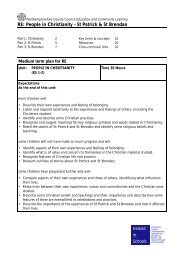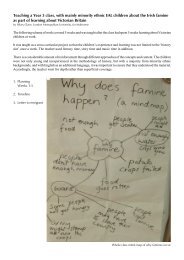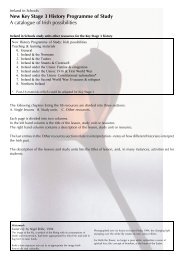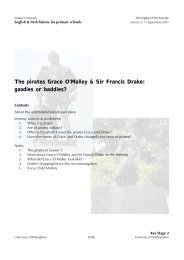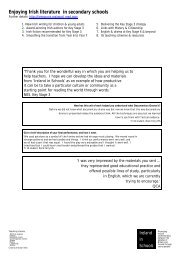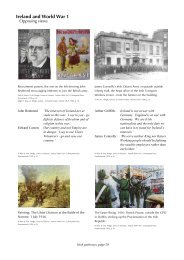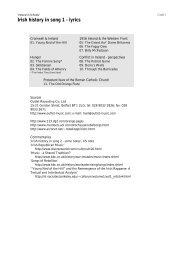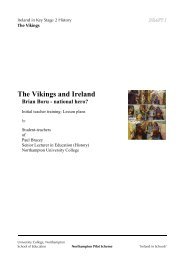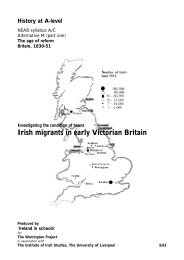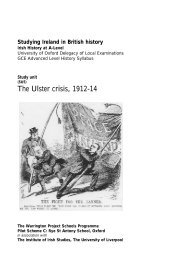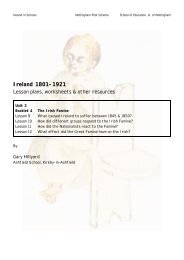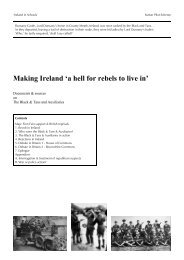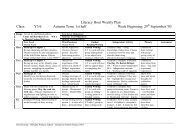Michael Collins - Ireland in Schools
Michael Collins - Ireland in Schools
Michael Collins - Ireland in Schools
Create successful ePaper yourself
Turn your PDF publications into a flip-book with our unique Google optimized e-Paper software.
‘<strong>Ireland</strong> <strong>in</strong> <strong>Schools</strong>’ Blackpool Pilot Scheme Learn<strong>in</strong>g & Achievement, CYPD<br />
National Secondary Strategy - Th<strong>in</strong>k<strong>in</strong>g Skills/Lead<strong>in</strong>g <strong>in</strong> Learn<strong>in</strong>g<br />
<strong>Michael</strong> <strong>Coll<strong>in</strong>s</strong><br />
A fortune l<strong>in</strong>e<br />
by<br />
Alison Montgomery, Collegiate High School, Sports College<br />
Contents<br />
About this unit<br />
Sequence of activities<br />
Glossary<br />
Fortune l<strong>in</strong>e<br />
Cards for sort<strong>in</strong>g<br />
Plenary - what, and how, have we learned?<br />
Note for teachers: The Anglo-Irish war<br />
For more resources on the Anglo-Irish war, please go to<br />
http://journals.aol.co.uk/iis04/trials/entries/896<br />
Watermarks<br />
Front page: <strong>Michael</strong> <strong>Coll<strong>in</strong>s</strong>, 1921<br />
Page 3: Neal Jordan directs Liam Neeson<br />
<strong>in</strong> the film<strong>in</strong>g of <strong>Michael</strong> <strong>Coll<strong>in</strong>s</strong>.
About this unit<br />
‘Fortune l<strong>in</strong>e’ or ‘Impact l<strong>in</strong>e’<br />
This unit of work revisits a strategy used earlier <strong>in</strong> this suite of materials.<br />
The fortune l<strong>in</strong>e <strong>in</strong> ‘Tudor <strong>Ireland</strong>’ sets out<br />
• to sequence events <strong>in</strong> the lives of Elizabeth I and Grace O'Malley;<br />
• assess the effects that events had on their lives; and then<br />
• compare the two life stories for relative fortune and misfortune.<br />
In this case, the ‘fortune' l<strong>in</strong>e becomes an ‘impact’ l<strong>in</strong>e. The issue here is not how events<br />
impact on <strong>in</strong>dividuals, but how <strong>in</strong>dividuals can <strong>in</strong>fluence events.<br />
The activity becomes a tool for fram<strong>in</strong>g an argument, as it addresses a range of viewpo<strong>in</strong>ts<br />
about the overall impact that <strong>Michael</strong> <strong>Coll<strong>in</strong>s</strong> had on events <strong>in</strong> Irish history. It enables<br />
pupils to come to an <strong>in</strong>formed conclusion, which they should be able to justify.<br />
‘Mov<strong>in</strong>g debate’<br />
The unit also revisits the strategy of the 'mov<strong>in</strong>g debate', which was used <strong>in</strong> the materials<br />
for 'Cromwell <strong>in</strong> <strong>Ireland</strong>'.<br />
Pupils are asked to place themselves on a cont<strong>in</strong>uum between two po<strong>in</strong>ts <strong>in</strong> the room<br />
accord<strong>in</strong>g to how far they agree or disagree with a judgmental statement (<strong>in</strong> this case:<br />
‘<strong>Michael</strong> <strong>Coll<strong>in</strong>s</strong> put <strong>Ireland</strong> on the road to <strong>in</strong>dependence’).<br />
There is a po<strong>in</strong>t <strong>in</strong> the middle for those who cannot come to a conclusion.<br />
All responses are acceptable, as long as they can justify their positions accord<strong>in</strong>g to what<br />
they have learned.<br />
After a sample of justifications, pupils are asked to reconsider their position based on how<br />
they have been persuaded by the arguments given.<br />
Preparation for GCSE<br />
The tasks <strong>in</strong> this unit should provide some preparation for the skills required at GCSE. It<br />
is therefore likely that it will appear towards the end of Key Stage 3, though there is<br />
noth<strong>in</strong>g to prevent it be<strong>in</strong>g taught earlier.<br />
Blackpool, Fortune l<strong>in</strong>e - <strong>Michael</strong> <strong>Coll<strong>in</strong>s</strong>, 2
Sequence of activities<br />
1. Us<strong>in</strong>g the fortune l<strong>in</strong>e on page 3 and the cards on pages 4 and 5,<br />
a. put the story of <strong>Michael</strong> <strong>Coll<strong>in</strong>s</strong> <strong>in</strong> chronological order.<br />
b. identify the high po<strong>in</strong>ts <strong>in</strong> his career and justify your op<strong>in</strong>ions.<br />
c. identify the low po<strong>in</strong>ts and justify your op<strong>in</strong>ions.<br />
2. How has <strong>Michael</strong> <strong>Coll<strong>in</strong>s</strong> <strong>in</strong>fluenced Irish History?<br />
Why do you th<strong>in</strong>k his <strong>in</strong>fluence grew so quickly?<br />
3. ‘<strong>Michael</strong> <strong>Coll<strong>in</strong>s</strong> put <strong>Ireland</strong> on the road to <strong>in</strong>dependence.’<br />
Us<strong>in</strong>g all the <strong>in</strong>formation <strong>in</strong> the activity, expla<strong>in</strong> how far you agree or disagree with<br />
this statement?<br />
Start this task with a ‘mov<strong>in</strong>g debate’.<br />
Glossary<br />
Boycott<br />
Constitution<br />
Dáil (doyle)<br />
Dom<strong>in</strong>ion<br />
IRA<br />
Loyalist<br />
Nationalist<br />
Republican<br />
Royalist<br />
S<strong>in</strong>n Fe<strong>in</strong><br />
Unionist<br />
Refusal to deal with a person or <strong>in</strong>stitution.<br />
A written document sett<strong>in</strong>g out pr<strong>in</strong>ciples on which a country is founded and<br />
the rights its people enjoy.<br />
Irish parliament.<br />
Self-govern<strong>in</strong>g <strong>in</strong>dependent state with<strong>in</strong> the British Empire.<br />
Irish Republican Army.<br />
Person who is loyal to the crown of the United K<strong>in</strong>gdom; an extreme unionist.<br />
Person who is loyal or passionately devoted to his or her own country.<br />
Extreme Irish nationalist who favours an <strong>in</strong>dependent 32-county republic,<br />
achieved by violence if necessary.<br />
Person who believes <strong>in</strong> government by monarchy, with a k<strong>in</strong>g or queen as head<br />
of state.<br />
An organisation that wanted to re-establish full political, economic and cultural<br />
<strong>in</strong>dependence of <strong>Ireland</strong> from Brita<strong>in</strong> through a policy of non-cooperation,<br />
<strong>in</strong>clud<strong>in</strong>g a boycott of parliament.<br />
Someone who believes <strong>in</strong> the union of <strong>Ireland</strong> with Brita<strong>in</strong>.<br />
Blackpool, Fortune l<strong>in</strong>e - <strong>Michael</strong> <strong>Coll<strong>in</strong>s</strong>, 3
Fortune l<strong>in</strong>e<br />
High<br />
Impact<br />
Low<br />
1890<br />
1900<br />
1910<br />
1920<br />
1930<br />
Blackpool, Fortune l<strong>in</strong>e - <strong>Michael</strong> <strong>Coll<strong>in</strong>s</strong>, 4
Cards for sort<strong>in</strong>g<br />
<strong>Michael</strong> <strong>Coll<strong>in</strong>s</strong> was born on the 16th October 1890 <strong>in</strong> County Cork.<br />
His first <strong>in</strong>fluences were his teacher Denis Lyons who belonged to the Irish Republican<br />
Brotherhood (IRB) and the village blacksmith, James Santry, who was a Fenian. He was<br />
told stories of Irish Patriotism. He grew up with a strong sense of pride <strong>in</strong> <strong>Ireland</strong> and<br />
<strong>in</strong> be<strong>in</strong>g Irish.<br />
At 15 <strong>Michael</strong> <strong>Coll<strong>in</strong>s</strong> moved to London. He worked as a clerk for the Post Office and he<br />
lived <strong>in</strong> a large Irish Community <strong>in</strong> London. He jo<strong>in</strong>ed S<strong>in</strong>n Fe<strong>in</strong> and the Gaelic League, and<br />
<strong>in</strong> 1909 became a member of the Irish Republican Brotherhood (IRB)<br />
In 1916 he returned to <strong>Ireland</strong> to take part <strong>in</strong> the Easter Ris<strong>in</strong>g. He received a<br />
Volunteer's uniform as Capta<strong>in</strong> <strong>Michael</strong> <strong>Coll<strong>in</strong>s</strong>. He played a m<strong>in</strong>or role <strong>in</strong> the Ris<strong>in</strong>g but<br />
his sense of duty and clear-headedness were remembered.<br />
Follow<strong>in</strong>g the Ris<strong>in</strong>g he was made a prisoner of war and was sent to Richmond Barracks<br />
and later Frongoch <strong>in</strong>ternment camp <strong>in</strong> Wales.<br />
He was released <strong>in</strong> December of the same year and went back to <strong>Ireland</strong>.<br />
His goal was to revitalise the campaign to get Independence for <strong>Ireland</strong>.<br />
Dur<strong>in</strong>g the Period between 1917 –1918, his activities <strong>in</strong>cluded:<br />
• Creat<strong>in</strong>g an <strong>in</strong>telligence network<br />
• Organis<strong>in</strong>g a national loan to fund a rebellion<br />
• Creat<strong>in</strong>g an assass<strong>in</strong>ation squad (‘The Twelve Apostles').<br />
With<strong>in</strong> 3 years of creat<strong>in</strong>g an <strong>in</strong>telligence network, <strong>Michael</strong> <strong>Coll<strong>in</strong>s</strong> was wanted by the<br />
British and had a price on his head.<br />
January 1919, the Anglo-Irish War began. The Royal Irish Constabulary became the<br />
target of a S<strong>in</strong>n Fe<strong>in</strong> terror campaign, which was arranged by <strong>Coll<strong>in</strong>s</strong>. He thought there<br />
was much to ga<strong>in</strong> by provok<strong>in</strong>g England to war.<br />
Blackpool, Fortune l<strong>in</strong>e - <strong>Michael</strong> <strong>Coll<strong>in</strong>s</strong>, 5
Dur<strong>in</strong>g the Anglo-Irish War <strong>Michael</strong> <strong>Coll<strong>in</strong>s</strong> had been made President of the IRB. At the<br />
same time he was made M<strong>in</strong>ister of F<strong>in</strong>ance <strong>in</strong> the Dail government and commander of<br />
the IRA.<br />
On 21st November 1920 <strong>Michael</strong> <strong>Coll<strong>in</strong>s</strong>' squad assass<strong>in</strong>ated 14 British officers,<br />
destroy<strong>in</strong>g the British Secret Service <strong>in</strong> <strong>Ireland</strong>.<br />
In retaliation for this assass<strong>in</strong>ation the British (Black and Tans) fired on a crowd<br />
watch<strong>in</strong>g a football match at Croke Park. 12 people were killed. The day became known as<br />
Bloody Sunday.<br />
Dur<strong>in</strong>g this period <strong>Coll<strong>in</strong>s</strong> fell <strong>in</strong> love with a woman called Cather<strong>in</strong>e Brigid Kiernan,<br />
commonly known as Kitty. From 1921 until his death they exchanged 300 letters. They<br />
became engaged at the end of 1921.<br />
In October 1921 <strong>Coll<strong>in</strong>s</strong> was sent to London to negotiate a treaty. They were difficult<br />
negotiations and took 3 months before <strong>Coll<strong>in</strong>s</strong> and Arthur Griffith agreed that <strong>Ireland</strong><br />
should have dom<strong>in</strong>ion status with<strong>in</strong> the British Empire (mean<strong>in</strong>g that <strong>Ireland</strong> could<br />
govern itself but rema<strong>in</strong> with<strong>in</strong> the British Empire).<br />
<strong>Coll<strong>in</strong>s</strong> simply saw the treaty as the start of a process that <strong>in</strong> his eyes would lead to full<br />
<strong>in</strong>dependence for what was now the Irish Free State. It is said that when he signed the<br />
treaty he said, ‘I tell you, I have signed my death warrant’.<br />
Some believed that <strong>Coll<strong>in</strong>s</strong> had sold out to the British government.<br />
Those that did not support the treaty fell <strong>in</strong>to violence and a civil war broke out. Many<br />
followed <strong>Coll<strong>in</strong>s</strong> <strong>in</strong> accept<strong>in</strong>g the treaty, and were known as ‘Regulars’. Those that didn't<br />
support the treaty were called ‘Irregulars’. He made every effort to avoid civil war. He<br />
drafted a new constitution, which he hoped would be acceptable to the republicans.<br />
Never a desk commander, on 22nd August 1922, <strong>Coll<strong>in</strong>s</strong> journeyed to County Cork. He<br />
was due to meet troops of the new Irish Army. His car was ambushed at a place called<br />
Beal na mblath and <strong>Coll<strong>in</strong>s</strong> was shot dead. To this day, no one is completely sure what<br />
happened or who killed him. No one else was killed <strong>in</strong> the ambush.<br />
Blackpool, Fortune l<strong>in</strong>e - <strong>Michael</strong> <strong>Coll<strong>in</strong>s</strong>, 6
Plenary - what, and how, have we learned?<br />
Work<strong>in</strong>g <strong>in</strong> pairs, consider the follow<strong>in</strong>g types of th<strong>in</strong>k<strong>in</strong>g:<br />
Information process<strong>in</strong>g skills<br />
Reason<strong>in</strong>g skills<br />
Enquiry skills<br />
Creative th<strong>in</strong>k<strong>in</strong>g skills<br />
Evaluation skills<br />
Suggest what you th<strong>in</strong>k each of these types of th<strong>in</strong>k<strong>in</strong>g require you to do.<br />
Which of these types of th<strong>in</strong>k<strong>in</strong>g do you th<strong>in</strong>k you have most used <strong>in</strong> this task?<br />
Expla<strong>in</strong> why you have decided this.<br />
In which other subjects have you used this type of th<strong>in</strong>k<strong>in</strong>g?<br />
Expla<strong>in</strong> what, when and how you have used it.<br />
Which life skills could this type of th<strong>in</strong>k<strong>in</strong>g prepare you for?<br />
Blackpool, Fortune l<strong>in</strong>e - <strong>Michael</strong> <strong>Coll<strong>in</strong>s</strong>, 7
Note for teachers: the Anglo-Irish War<br />
Adapted from The Oxford Companion of Irish History, edited by S.J. Connolly, OUP, 0-19866-240-8, pp 15-16, 47<br />
Republican campaign<br />
The Irish Volunteers, now <strong>in</strong>creas<strong>in</strong>gly known as the Irish Republican Army (IRA), mounted an armed campaign, now called<br />
the Anglo-Irish war, aga<strong>in</strong>st government forces <strong>in</strong> <strong>Ireland</strong> to defend the Irish Republic established <strong>in</strong> 1916. The campaign is<br />
conventionally dated from 21 January 1919, when n<strong>in</strong>e Volunteers, <strong>in</strong>clud<strong>in</strong>g Dan Breen and Sean Treacy, killed two<br />
policemen <strong>in</strong> an ambush at Soloheadbeg, Co. Tipperary. It cont<strong>in</strong>ued until a truce on 11 July 1921 opened the way for the<br />
negotiation of the Anglo-Irish treaty, concluded on 6 December 1921.<br />
Guerrilla warfare<br />
The development of a highly effective form of guerrilla warfare, wholly different from the tactics of the ris<strong>in</strong>g of 1916 or<br />
earlier <strong>in</strong>surrections, represented a gradual adaptation to practical necessity, dependent more on local <strong>in</strong>itiative than on<br />
central plann<strong>in</strong>g. IRA activity dur<strong>in</strong>g 1919 consisted ma<strong>in</strong>ly of arms seizures and attacks on <strong>in</strong>dividual policemen. A<br />
successful attack on the police barracks at Carrigtwohill, Co. Cork, on 2 January 1920, marked the commencement of more<br />
ambitious raids and ambushes. By June the IRA had killed 55 police. Sixteen occupied barracks had been destroyed <strong>in</strong><br />
attacks, and hundreds of others abandoned as <strong>in</strong>defensible. In Dubl<strong>in</strong> members of a squad directed by <strong>Michael</strong> <strong>Coll<strong>in</strong>s</strong> had<br />
begun systematically kill<strong>in</strong>g off detectives from the political division of the Dubl<strong>in</strong> Metropolitan Police.<br />
British response<br />
In response to this challenge the government deployed regular troops and created two new forces, the Black and Tans 1 and<br />
Auxiliaries, to re<strong>in</strong>force the Royal Irish Constabulary (RIC). The Restoration of Order <strong>in</strong> <strong>Ireland</strong> Act cont<strong>in</strong>ued and extended<br />
the emergency powers created by the wartime Defence of the Realm Acts. But the draconian security policy alienated the<br />
civilian population without suppress<strong>in</strong>g IRA activity. The events of late 1920, notably ‘Bloody Sunday’ (21 Nov) and the<br />
kill<strong>in</strong>g of fifteen Auxiliaries <strong>in</strong> an ambush at Kilmichael, Co. Cork (28 Nov), marked a sharp escalation <strong>in</strong> violence. The<br />
same period saw the appearance of ‘fly<strong>in</strong>g columns’, bodies of IRA men permanently under arms of the k<strong>in</strong>d led by Tom<br />
Barry <strong>in</strong> Co. Cork and responsible for the Kilmichael ambush. Cont<strong>in</strong>ued violence <strong>in</strong> the first half of 1921 brought the total<br />
death toll for the period to 405 police, 150 military, and an estimated 750 IRA and civilians.<br />
IRA’s war<br />
The term ‘Anglo-Irish War’, like the older ‘War of Independence’, raises complex issues. IRA activists and leadership<br />
determ<strong>in</strong>edly employed the vocabulary of conventional warfare to assert their status as combatants <strong>in</strong> a national conflict. In<br />
do<strong>in</strong>g so they glossed over the sporadic, hit-and-run character of most operations, the limited scale of the violence prior to<br />
late 1920, and the predom<strong>in</strong>ance among the early victims of the IRA of the locally recruited, and predom<strong>in</strong>antly Catholic,<br />
RIC.<br />
British government’s police action<br />
The government was equally determ<strong>in</strong>ed to deny the ‘murder gang’ the legitimacy of belligerent status. It condoned reprisals,<br />
<strong>in</strong>clud<strong>in</strong>g the widespread destruction of property <strong>in</strong> such <strong>in</strong>cidents as the Black and Tan raid on Balbriggan, Co. Dubl<strong>in</strong>, on<br />
20 September 1920, and the ‘sack’ of Cork city by Auxiliaries and Black and Tans on 11-12 December 1920. It also ignored<br />
the assass<strong>in</strong>ation, clearly by security force members, of several republican activists. But Lloyd George’s <strong>in</strong>sistence that ‘you<br />
do not declare war on rebels’ meant that the military never got a really free hand, and that authority rema<strong>in</strong>ed confus<strong>in</strong>gly<br />
divided between police and army.<br />
Status of IRA<br />
Assessment of the IRA’s claim to represent the popular will is also difficult. Modern historians, react<strong>in</strong>g aga<strong>in</strong>st an earlier<br />
tradition of uncritical glorification, have emphasized the extent to which violence was deliberately employed by a militant<br />
m<strong>in</strong>ority to block any possibility of a compromise settlement, and the ruthless action, shad<strong>in</strong>g <strong>in</strong>to a more general<br />
<strong>in</strong>timidation, aga<strong>in</strong>st ‘<strong>in</strong>formers’ and ‘collaborators’. IRA activity was geographically uneven, high levels of activity <strong>in</strong> the<br />
western counties of Munster and part of the midlands contrast<strong>in</strong>g sharply with relative tranquillity elsewhere. Although the<br />
Dail had declared as early as January 1919 that a state of war existed between Brita<strong>in</strong> and <strong>Ireland</strong>, a section of S<strong>in</strong>n Fe<strong>in</strong> was<br />
known to be unhappy with the bloodshed. IRA activists for their part demonstrated a reluctance to submit to the authority<br />
either of Volunteer GHQ or of the ‘politicians’ of Dail Eireann. These divisions were later to contribute to the Civil War of<br />
1922-3. But for the moment what was remarkable was the success with which differences were concealed <strong>in</strong> the face of a<br />
common enemy.<br />
1 Black and Tans<br />
The failure of the Royal Irish Constabulary to combat IRA raids <strong>in</strong> 1919 conv<strong>in</strong>ced the government that the police needed to be re<strong>in</strong>forced. From January 1920<br />
British ex-soldiers and sailors were recruited and, by November 1921, some 9,500 such men had jo<strong>in</strong>ed the RIC. A shortage of RIC uniforms meant that recruits<br />
were issued with khaki military trousers and dark green police tunics. Although full RIC uniforms were soon substituted, this mixed dress gave rise to the new<br />
policemen’s dist<strong>in</strong>ctive sobriquet, the Black and Tans. Hurriedly and <strong>in</strong>adequately tra<strong>in</strong>ed, recruits were posted to RIC barracks, ma<strong>in</strong>ly <strong>in</strong> Munster, west Connacht,<br />
and Dubl<strong>in</strong>. Thus strengthened, the RIC from mid-1920 was encouraged to pursue the IRA more vigorously. The government, at first tacitly and then openly,<br />
condoned reprisals by the police. The lead<strong>in</strong>g role of the Black and Tans <strong>in</strong> some of these <strong>in</strong>cidents may have been exaggerated, as British-born and Irish-born<br />
policemen were difficult, when <strong>in</strong> full uniform, to tell apart. Nevertheless, the Black and Tans ga<strong>in</strong>ed a fearsome reputation for brutality, which only helped alienate<br />
the population from the RIC as a whole. Of policemen recruited <strong>in</strong> 1920–1 over one-third died, were dismissed or discharged, or resigned: a very high wastage rate<br />
<strong>in</strong>deed, attest<strong>in</strong>g both to the difficulties of service and to the <strong>in</strong>adequacies of recruits. But 63 per cent went on to secure government pensions when the RIC was<br />
disbanded <strong>in</strong> 1922.<br />
‘<strong>Ireland</strong> <strong>in</strong> <strong>Schools</strong>’, 19 Woodlands Road, Liverpool L17 0AJ. Email: iis02@aol.com. Internet: http://iisresource.org



